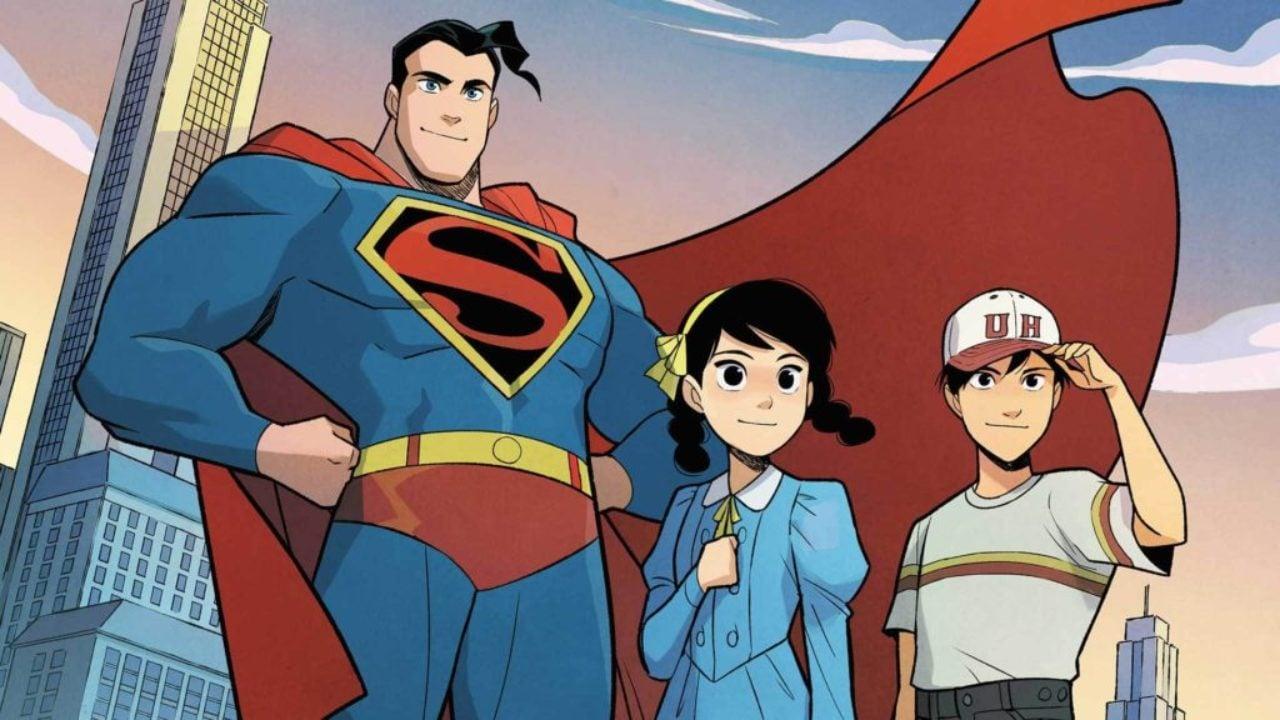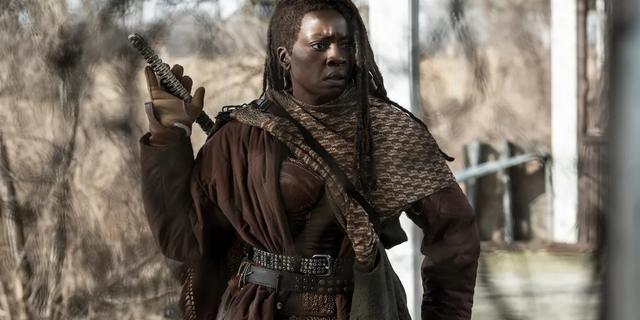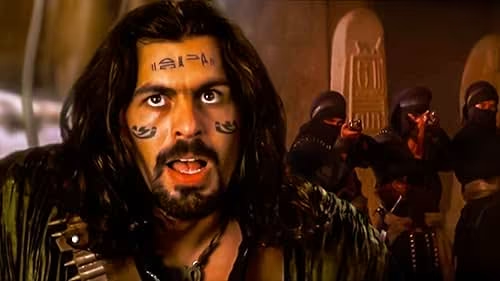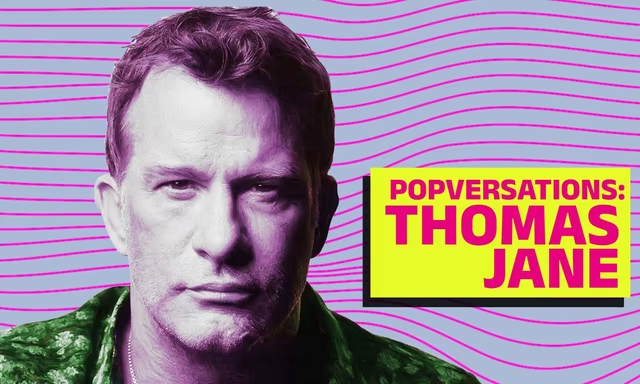If you click on a link and make a purchase we may receive a small commission. Read our editorial policy.
Gene Luen Yang and the quintessential American superhero, Superman
A deep dive into Gene Luen Yang's body of work and how led him to become the best modern Superman writer

For Popverse's first birthday, we are making several of our most popular members-only pieces available to the general public at large for a limited time. These pieces represent some of the best writing here at Popverse by our team, and are just sample of what you can enjoy on a weekly basis by coming a paid Popverse member.
Gene Luen Yang is a MacArthur Genius recipient, an Ambassador for Young People’s Literature as appointed by the Library Of Congress, and a teacher and educator. He is one of the best and finest cartoonists in Western Comics, and he is also an equally accomplished comics writer when he is not drawing.
Yang's work has been incredibly varied and diverse, spanning from genres like historical interpretation (Boxers & Saints) to contemporary coming-of-age dramas (American Born Chinese) to sports epics (Dragon Hoops) to educational comics about coding (Secret Coders). He’s worked on and created short-stories, anthologies, mini-series, maxi-series, ongoing titles, and original graphic novels. Yang is, simply put, a creator who can do anything and everything.
But over the past decade, Gene Luen Yang has become known for something else too, something much more specific:
Gene Luen Yang is perhaps the best modern Superman writer.
Alongside the likes of the legendary Grant Morrison, and the brilliant Greg Pak, Yang has done seminal work on the character for the 21st century. His all-ages graphic novel Superman Smashes The Klan with artistic duo Gurihiru is a book for the ages. Alongside the likes of All-Star Superman, Superman Smashes the Klan is a perennial take on the character meant to last, reworking the iconic Superman Radio Show story addressing a standin for the KKK (when it originally aired, it helped deal a blow to the popularity of KKK). It’s stellar work, building off of Yang’s experience with two prior stints on the Super-mythos, New Super-Man, following a Chinese Superman, and the main Superman title during the DCYou initiative.
But why does Yang’s vision gel so well with Superman, a character who so many creators seem to have struggled with? What makes Yang's sensibilities such a wonderful fit for the character? And what exactly is so refreshing and unique about his take on the material?
Let’s dig into that.
Fantasy and Reality

Often, the earliest works of a creator are the most revealing. These works are the rawest expressions of their interests and ideas as artists. This very much holds true with Yang when looking at Animal Crackers, one of his first projects.
Split across three stories- Gordon Yamamoto and The King Of The Geeks, Sammy The Baker and The M.A.C., Loyola Chin and The San Peligran Order- the collection lays out the core thematic obsession of Yang’s entire career:
The disparity between fantasy and reality, and how being caught amidst them affects and shapes the lives and identities of people.
Gordon Yamamoto is a typical bully you’d expect in an 80’s film, and Miles Tanner is a typical geek you’d find as his victim. But Yang takes that stereotypical set-up and morphs it into one wherein both individuals are made to confront the realities of one another’s lives, shattering their respective fantastical constructions, to illuminate and bring about compassionate connection.

This twist is perhaps best embodied in the conclusion of the story where all of Miles’ fantasies towards his alcoholic father are manifested. Every single angry thought or rage-induced idea of how he’ll ‘get back at him’ or ‘make him pay’ is unleashed and given form as a real, walking, talking, harmful construct. Confronted with the horror his fantasies have unleashed, Miles realizes that they're not really what he wants in life, or the kind of person he wants to be. He must let go of those fantasies, and re-orient.
The notion recurs once again in the story of Sammy The Baker, in which, once again, suppressed feelings are made manifest as constructs, and must be dealt with. With this story, a pattern is set, where over and over again, these characters are confronted with the ideas of who they are and aren’t, and must come to grips with reality.
And the way the final story- Loyola Chin, broaches that is telling. Loyola is a teenage girl who finds little joy in her real life, but finds endless delight in dreams with her dream man and lover Saint Danger, a nigh demi-god figure. Saint Danger is a real-life cult-leader who appears and meets with Loyola in dreams, performing the role of her ideal man. Loyola ignores her real relationships and the sincere attempts at connection by Gordon Yamamoto, who is in love with her. And in the end, it turns out that Saint Danger is far from the kind of lovely angelic man Loyola once believed he was. He was, in the end, a fantasy. And by the end, she must confront reality and leave behind her fantasy.

Animal Crackers as a whole is an interesting collection framed around dual perspectives, and how only our connections really save us, and how sometimes things, life, even our dreams and fantasies, they're not really what they seem. Animal Crackers is a story of how our fantasies make us into monsters, and how our dreams can sometimes be destructive distractions from which we need to free ourselves to truly live and be alive.
This interest with fantasy and reality and how they shape one’s identity and life recurs once again in perhaps Yang’s most well-known and legendary work- American Born Chinese. Soon to be a big TV show on Disney+ directed by Destin Daniel Cretton of Shang-Chi fame, starring Michelle Yeoh, Ke Huy Quan, and Stephanie Hsu reuniting from Everything Everywhere All At Once, American Born Chinese primarily follows two dual narratives, interspersed with the presence of The Monkey King.

In the graphic novel, we meet Jin Wang, a Chinese-American boy and follow his young formative days and relationships with other Asian-American kids in a largely White school environment. What is it like to be the few Asian-American kids in such a space? How do young kids deal with that?
In another storyline, we follow Daniel, a White-passing boy who finds his life constantly upset every time his Chinese cousin visits him.

The two dual narratives explore Asian presence in predominantly White spaces, and, while reading, it's easy to believe you think you know this story, but then you come to learn the truth. These are not two different stories. They’re one story.

Jin Wang is Daniel.
Jin Wang was so tired of being Asian that he just wanted to not be that. He wanted to be White-passing Daniel, and what we’re seeing is his fantasy construction throughout. It’s how he’s grown up, with that self-hatred and veil of Whiteness hanging over him and his imagination.
But that’s not really who he is, is it?
Only when confronted with who he actually really is and wants to be, as opposed to his fantasies born from pain, is Daniel really able to move forward. Only then is he able to embrace reality and then build new fantasies, new dreams, that are much more fulfilling and joyous and beautiful.
You see the fascination with this thematic territory again and again in Yang’s work, appearing once more in his wonderful Eternal Smile collection of short-stories, and even more strikingly in his Boxers and Saints. Dualities are, of course, a favorite narrative device by which Yang loves to explore the divides between our fantasies and realities. And it’s true of all of the above works.
Which is perhaps why his superhero work resonates so well.
The American Superhero

Superman and New Super-Man are probably the most well-known examples of Yang’s superhero work, given the sheer reach of an icon like Superman.
But neither of these books were the first time Yang had written superheroes.
Yang's first superhero project was The Shadow Hero with Sonny Liew, which examined the ancient Golden Age character of The Green Turtle created by Chu F. Hing, one of the first Chinese-American cartoonists. In 1944, The Green Turtle was not permitted to be explicitly Chinese in-text, but Hing would not relent and make him White either. In a show of defiance, Hing would never show the Turtle's face, reveal the true complete look of the character, or provide his real name, thus allowing the character to still remain Chinese-American, and allowing his intended readership to read him as such. In The Shadow Hero, Yang would seize upon this idea and devote a whole graphic novel to expand and explore the character as a fully realized individual. He would even give this hero a name that he never had- Hank Chu.
As Yang himself put it at the Oakland Asian Cultural Center last year:
“I was thinking about, y’know when I first read about The Green Turtle, why I was so… like I stayed up nights thinking about this guy with no shirt and a green cowl, right? And I think it’s because of this: As Asian-Americans, we struggle with perception of perpetual foreignness. Like it doesn’t matter if we were born here, it doesn’t matter how long our family’s been here. There are certain segments of American society that always see us as foreign. And for me, superheroes are a deeply American genre. They were born in America. They came of age as America was asserting itself as a superpower on the world stage. I think there is something fundamentally American about superheroes. So to find out there was this character who dates back to the very very early days of American Superheroes, 1945- that’s less than a decade after Superman was created, it just felt like Comic Book History was telling me:
People like you have always been here, even if you’ve had to hide your face. There’s just something deeply affirming about the fact that The Green Turtle existed.”

And so The Shadow Hero became very much about fantasy and reality, too. The reality of the Chinese-roots mixed with the fantastical color and bombast of American life. The superhero would become the ultimate construct of American Identity, in the hands of Yang.

Within the story, a simple superhero suit becomes the manifestation of an Asian-American mother’s fantasy and dream for her son. A superhero symbol becomes a Chinese character embodying culture and history, which Hank Chu carries with him. The superhero is the ultimate American construct, the identity of American power and excellence, and so if her son can be that, then the immigrant dream has been fulfilled. The land of opportunity will have delivered, and all the hard work will have been worth it.
The Shadow Hero follows Hank Chu, The Green Turtle, dealing with that societal construct and wrestling with this identity- figuring out what it truly means to be Hank Chu and The Green Turtle.

By the end of the comic, Yang firmly defines his view and vision of the superhero in unmistakeable terms, as the comic's Superman-pastiche reveals that he, too, is an immigrant. Through this revelation, Yang resets the very basis and idea of superheroes as steeped in the cutlure of immigrants and those who have been marginalized, which echoes the real history of comics, given the American comics industry was largely built by Jewish creators in incredibly trying times. And building off that, with The Green Turtle’s very existence, Yang suggests that the superhero has always been a construct of and for the marginalized of America. The superhero belongs to Jewish people, but it also belongs to all other immigrants and marginalized peoples of America. Yang centers that specificity which can often get lost as superheroes become broad strokes blank-slate projection points and empty IP signifiers. He understands that this means something and what makes it special is its specificity.
The superhero is the ultimate American construct, which means it is the ultimate immigrant construct.
With The Green Turtle, Yang explores the specific touchstone of the superhero in-relation to the Asian-American experience. The superhero becomes a manifestation of that very hyphen between ‘Asian’ and ‘American’ in his hands, the bridge between worlds that binds the cultural heritage and dreams of the Asian immigrant parents and the aestheticism and power of American ideas.
The superhero isn’t just an abstract White figure of Americana to Yang. He’s a deeply specific metaphor bound to immigrant experience and marginalization.
Which is perhaps why his take on Superman, the very root and origin of superheroes, is so effective.
Gene Luen Yang and the Superman

Gene Luen Yang would first tackle Superman during 2015’s DCYou initiative, alongside fellow Asian-American creator Greg Pak. Pak would write Action Comics, while Yang would wrote Superman. Here Superman was deeply depowered, unable to fly or do any of the fantastical things he once could, back to his Golden Age roots of strong punching and gigantic leaps. His identity as Clark Kent had been outed, the precarious balance of perpetually keeping one side of himself forever hidden now ripped away from him.
Superman was out in the light, and Yang would define what that meant.
And whilst the era and run would exist in a period of tumult and editorial edicts and other tricky demands, immediately, Yang would posit a wild, radical, and fascinating idea in his work with the character.
Yang's Superman is very much an ‘outsider’ and someone who feels out of place, like an alien, with all the implications of that genre word translated to its true meaning: immigrant. This framework was very much in line with Greg Pak’s work, and was deeply in dialogue with it.

But the really striking and memorable idea by Yang?
It was this:

Yang posits that Superman is loved and has been loved not for who he is but rather for what he can do, specifically through a racial metaphor context. He is not loved or idealized or placed on a pedestal for his goodness or personality, but for his power.
The second that power is stripped from him, and the second his very literal identity (in the form of his Clark Kent persona) is revealed, it all comes crashing down. Superman is the marginalized figure put on an impossible pedestal and dehumanized via romantic idealization. He’s the ‘model minority’ figure judged by an impossible standard. He's put on that pedestal just to be knocked down at the first sign of a flaw or 'weakness' or error. The bar for people like him is high, as others can get away with everything and anything, but he cannot. He doesn't have that luxury. He must be absolutely perfect and the best, and the second he's not, boom.
Yang writes Superman as a symbol for Asian-Americans and their experience, as well as the broader experience of the marginalized at large. And in so doing, Yang makes it personal to himself and his work.

Yang surrounds Superman with a cavalcade of Asian characters and settings featuring him eating Asian food and having Asian drinks. And in telling panels like above, Yang has Asian characters tell security at Asian establishments “He’s legit. I know he looks like one of them, but really, he’s like us.”
Superman is a figure who can pass amongst the White majority, but he is not them. His struggle and journey with his dual heritage and culture, having two names, is something Yang himself finds great beauty and relatable potency in. And so emerges his Superman, his Clark Kent, a man who feels deeply, both love and rage, passion and pain, and who deals with the hard, impossible cards he’s been dealt.
If Superman and the superheroes are American Constructs, what do they tell us about American culture? That’s what Yang is investigating, in using that construct and metaphor. And of course, to love the marginalized for their capacity or special capability, to love the end-results of those capacities, but to not care for those people themselves and hold them to impossible standards is very true to the American hegemony.
Superman's identity being revealed essentially allows for the exploration of the dueling ideas- the fantasy and construction of Superman as held by American hegemony and society at large vs the actual reality of who Superman truly is as a person. When confronted with the reality of this relationship, Clark is deeply hurt. He’s reluctant to accept it, but he must accept it, painful as it is. He cannot live in fantasy, he must embrace the reality of the matter. He cannot run from what is staring him right in the face.
When Yang would go onto do his evergreen take on the character in Superman Smashes The Klan, all this would all become even more apparent.

In Superman Smashes the Klan, Yang would firmly center Superman as an immigrant (which is what alien means) and put it right next to the Othering ideas of Orientalism, as the above page demonstrates clearly. The book follows a Chinese-American family that just moved to America and the bigotry and horrors they encounter and experience, with their young daughter Roberta Lee being the central figure. Throughout the Lee's struggles, Superman would come in and help, while dealing with his own sense of feeling out of place, like an immigrant, with all that it entails.
And in a way, it makes perfect sense. Superman Smashes the Klan feels like the book Yang was always meant to write. Of course a creator obsessed with the interactions and divides between fiction and reality and how they shape lives would be taken by the real world history of a fictional Superman Radio Show story that did real damage to the KKK. The Superman Radio Show made a fiction so effective, a construct so strong, that it had a material effect on society. And it was the story of a Chinese-American family at the same time.
In the end, it’s no shocker that Yang would go on to become one of the best Superman writers and superhero creators on top of being one of our great American cartoonists. In his hands, the American superhero becomes a very personal vehicle and a construct to speak to real things, and real lived-in experiences. He uses the superhero as a metaphor in the best way genre fiction does, to examine and unearth truth. He is one of the rare modern Superman writers who also happens to have this unique background to bring an authenticity to the character.
Superheroes are the perfect construct for what Yang has always written about, and it’s why he keeps returning to Superman and the superheroes, time and time again.
‘You’re caught between worlds. And in a lot of ways, that’s what spoke to me about superhero comics. Superheroes, they just have to navigate between these two worlds, right? It made sense to me.” - Gene Luen Yang
Become a Popverse member and check out Disney’s American Born Chinese Panel, featuring Gene Luen Yang, from NYCC right here!
Follow Popverse for upcoming event coverage and news
Find out how we conduct our review by reading our review policy
Let Popverse be your tour guide through the wilderness of pop culture
Sign in and let us help you find your new favorite thing.
















Comments
Want to join the discussion? Please activate your account first.
Visit Reedpop ID if you need to resend the confirmation email.